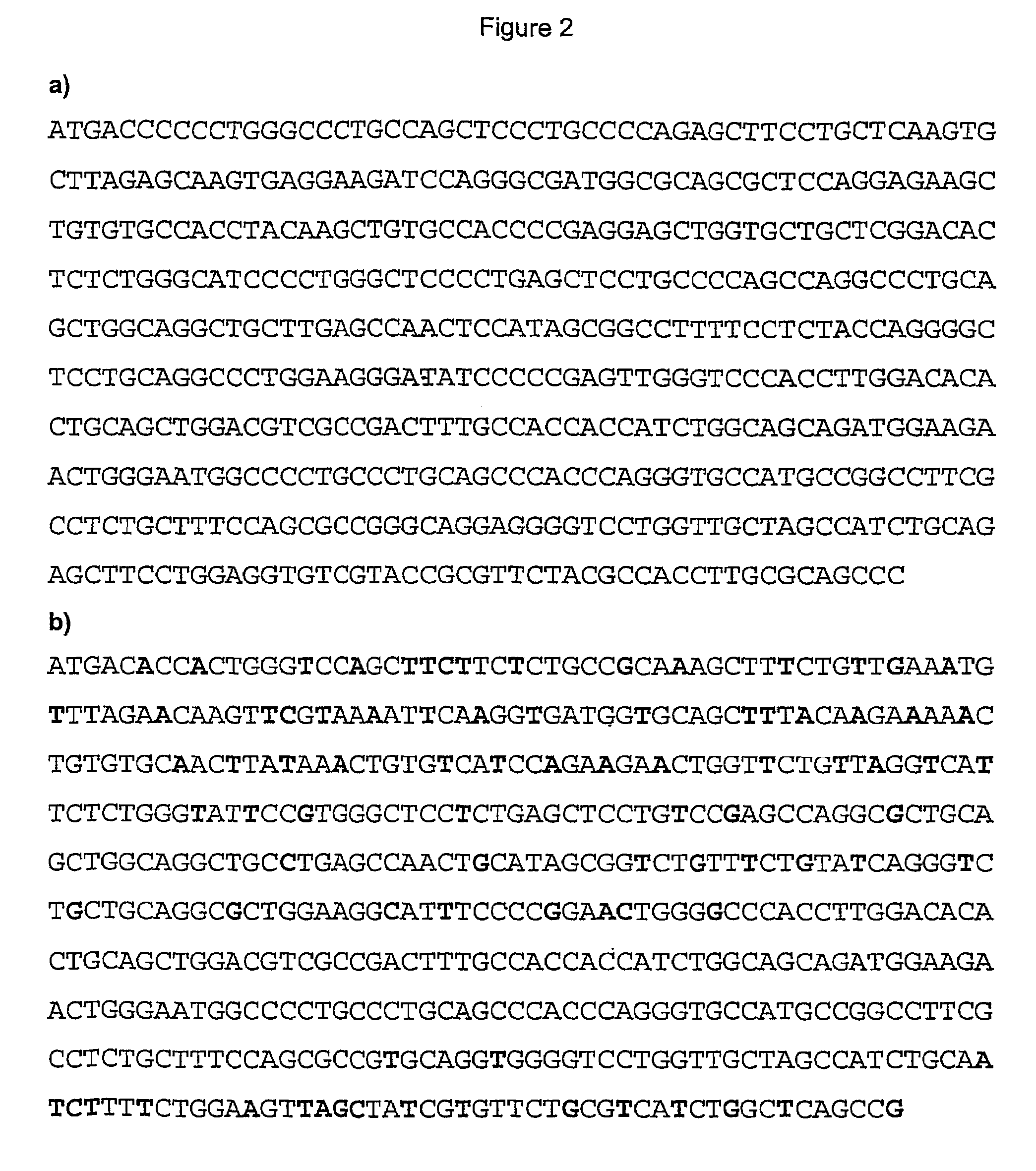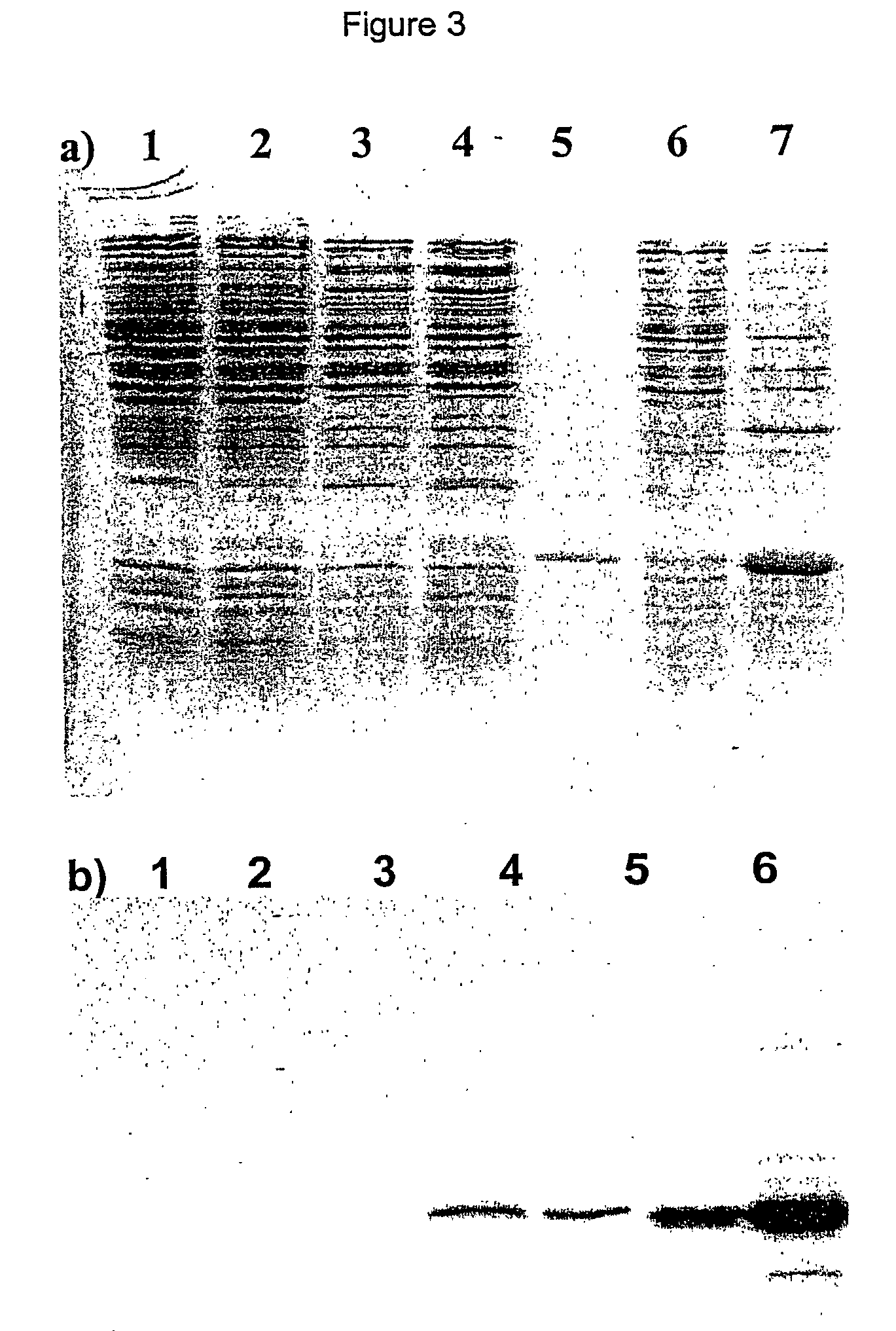Synthetic gene coding for human granulocyte-colony stimulating factor for the expression in E. coli
a technology of granulocyte colony and synthetic gene, which is applied in the direction of antibacterial agents, extracellular fluid disorders, immunological disorders, etc., can solve the problems of insufficient level for the economical large-scale production of hg-csf, less economical in large-scale production, and lower production yields, so as to improve the expression level.
- Summary
- Abstract
- Description
- Claims
- Application Information
AI Technical Summary
Benefits of technology
Problems solved by technology
Method used
Image
Examples
example 1
Construction of the Optimal Gene: Fopt5
Example 1a
The Initial Gene and Plasmid Preparations
[0067]The gene coding for hG-CSF, defined by SEQ ID NO:3, was amplified from BBG13 (R&D) with the PCR method, which was also used to introduce by using the start oligonucleotides the restriction sites NdeI and BamHI at the start and terminal end of the gene. The gene was then incorporated in the plasmid pCytexΔH,H (see the description below) between the restriction sites NdeI and BamHI. All other optimization steps for the expression of the gene in E. coli were also performed in this plasmid.
[0068]During the initial gene preparation the EcoRV restriction site was annihilated (oligo M20z108, defined by SEQ ID NO:4) by point mutation. This was performed with the aim to ensure the possibility of introduction of (individual) mutations by using the oligonucleotide-directed mutagenesis in the plasmid pCytexΔH,H with the kit Transformer™ Site-Directed Mutagenesis Kit (Clontech). The selection of mutan...
example 1b
Codon Optimization (FIG. 1)
[0071]In a first optimization step the synthetic gene between the restriction sites NdeI and SacI was constructed by ligation of five cassettes (A, B, C, D, E) which were composed of complementary oligonucleotides. This synthetic part of the gene represents the segment I. With the segment I, the part of the native gene for hG-CS F (SEQ ID NO:3)between the restriction sites NdeI and SacI was replaced. This was performed by the excision of the first part of the gene between the restriction sites NdeI and SacI, and replacement with the synthetically prepared cassette. The process was performed in two steps. In the first step, the cassette A, defined by SEQ ID NOS:5 and 6, was ligated to the NdeI site and the cassette E, defined by SEQ ID NOS:13 and 14, was ligated to the SacI site. After 16 hours at 16° C. the ligation mixture was precipitated with ethanol to remove the excess of unbound oligonucleotides. In a second step the central part of the whole cassett...
example 2
Expression of the Synthetic Gene Coding for hG-CSF in E. coli
[0088]The optimized gene Fopt5, defined by SEQ ID NO:1, was excised from the plasmid pCyΔH,H with the restriction enzymes NdeI and BamHI and the gene was then subcloned in the final expression plasmid pET3a (Novagen, Madison USA), which contains an ampicilline resistance gene, which was then transformed into the production strain E. coli BL21 DE3).
The cultures were prepared on a shaker at 160 rpm for 24 hours at 25° C. or 15 hours at 42° C.:
[0089]in LBG10 / amp100 medium (10 g / l tryptone, 5 g / l yeast extract, 10 g / l- NaCl, 10 g / l glucose, 100 mg / l ampicillin). The induction was performed with the addition of IPTG to the final concentration of 0.4 mM.
The cultures were prepared on a shaker for 24 hours at 160 rpm at 25° C.:[0090]in GYSP / amp100 medium (20 g / l phytone, 5 g / l yeast extract, 10 g / l NaCl, 10 g / l glucose, metals in traces, 100 mg / l ampicillin). The induction was performed with the addition of IPTG into the medium t...
PUM
| Property | Measurement | Unit |
|---|---|---|
| temperature | aaaaa | aaaaa |
| temperature | aaaaa | aaaaa |
| temperature | aaaaa | aaaaa |
Abstract
Description
Claims
Application Information
 Login to View More
Login to View More - R&D
- Intellectual Property
- Life Sciences
- Materials
- Tech Scout
- Unparalleled Data Quality
- Higher Quality Content
- 60% Fewer Hallucinations
Browse by: Latest US Patents, China's latest patents, Technical Efficacy Thesaurus, Application Domain, Technology Topic, Popular Technical Reports.
© 2025 PatSnap. All rights reserved.Legal|Privacy policy|Modern Slavery Act Transparency Statement|Sitemap|About US| Contact US: help@patsnap.com



